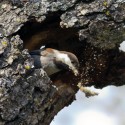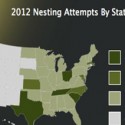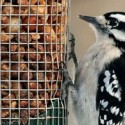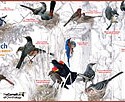 Photo ©
Keith Williams
Photo ©
Keith Williams

Creating starter holes for cavity-nesting birds
If you have put up a nest box, you may have noticed that during the breeding season it becomes prime real estate. As you may know, nest boxes are substitute cavities (a cavity being any hole in a tree), often placed in areas where there are no longer standing dead trees which provide natural cavities. But did you know that you can create starter holes which will eventually become cavities? There are several advantages to cavities over nest boxes: they require less maintenance, are inconspicuous to the public, and appeal to a wider variety of birds.
To start a natural cavity, find a tree whose heartwood is rotten but which still has intact bark; strong bark keeps predators from enlarging the entrance hole. Drill a 2″-diameter hole into the heartwood about 3″ below a stout limb. This is a great entry point for a chickadee to begin excavating the rotten wood! If you can do this on a downward-facing side of a tree, that will help to keep the rain out. You can also start a cavity by cutting a limb of at least 3″ in diameter from the tree, leaving about 6″ of limb on the trunk (this is called the branch collar). The cut limb will rot and the tree will heal around the hole. In cold-climate regions, consider orienting cavities to the south or east to maximize their sun exposure. In warmer climates, cavities may be oriented north or west to reduce overheating. Keep in mind that cavities should be started in appropriately-sized trees and of sufficient height to attract your target species. Don’t have a target species? Start your cavity in the 6-10′ height range, and then just let it rot.

Bring it on!
Even though the weather is cooling down, the competition for the ultimate NestWatching state is just heating up. If you’ve had a chance to explore our new home page at NestWatch.org, you may have noticed a little map of 2012 nesting attempts by state that features the most common species monitored for NestWatch. By clicking on a bird image, you can access that species’ data entry map; the darker the state, the more attempts have been entered by volunteers in that state. Mouse over the states on these maps to find out how many attempts have been recorded so far for each species. Cool, right?
Now, here’s your chance to turn those data into great prizes. We invite you to participate in a friendly challenge to predict which states will reign supreme when it comes to entering data for some of America’s favorite nesting birds. Each week on our Facebook page, we’ll post a new bird species along with the current top 5 state leaderboard. Look at the data entry stats for that week’s species on our home page, then make your predictions for what the top 5 states will be at the end of the year using the voting link provided in the Facebook post. One point will be awarded for each correct rank. On December 14, final tallies of nesting attempts entered in 2012 per species will be calculated for each state, and the person with the most correct rankings will win a free Cavity-nesting Birds poster, Common Nesting Birds poster, and a Bluebirds Inside the Nest Box DVD. Visit us on Facebook for a new species challenge every week until Thanksgiving, and be sure to enter your nesting data soon because you just may be a game-changer. May the best fan win!

Become a FeederWatcher
Help the Cornell Lab of Ornithology learn about the habits of backyard birds by participating in Project FeederWatch. Anyone with an interest in birds and nature can participate in the project. The information you and others report online helps scientists at the Cornell Lab track changes in the numbers and distribution of birds across the continent.
“By watching and keeping track of the birds in your own neighborhood, you really can make a difference,” says project leader David Bonter. “The more people watching, the more we can learn about the birds that brighten the winter landscape.”
More than 50,000 people have participated in FeederWatch, and new participants are welcome to join at any time. The 26th season of Project FeederWatch begins November 10. Join today and receive your kit before the new season begins.
Glad you asked
This month, we’re introducing a new column to our eNews that focuses on finding and getting the help you need with NestWatch. To kick things off, we’re answering a common question this time of year: “I have some boxes in which the birds had a second nesting in the same box. How do I enter this data?”
You should create a new nest attempt in NestWatch each time a pair begins a new clutch (whether it’s the same pair or a different one). Once the nest fledges or fails, you should end the attempt by:
- clicking “Save and Summarize Attempt”
- entering the summary information, then
- clicking “Save & End This Attempt”
Once you have done this, you will again have the option to “Add an Attempt”, which will allow you to create additional attempts for subsequent nestings.
Whereas open-cup nests may never be used again, it is particularly important for nest box monitors to recognize each nesting as a unique attempt. We ask that you not submit multiple consecutive nestings under the same attempt because the data summaries from such entries are inaccurate, and therefore, much more difficult to interpret.

Monthly Winner
At the beginning of each month, NestWatch randomly selects one participant to receive a copy of the NestWatch Common Nesting Birds of North America poster. This month’s lucky winner is Paulette Nickerson. Congratulations, Paulette!